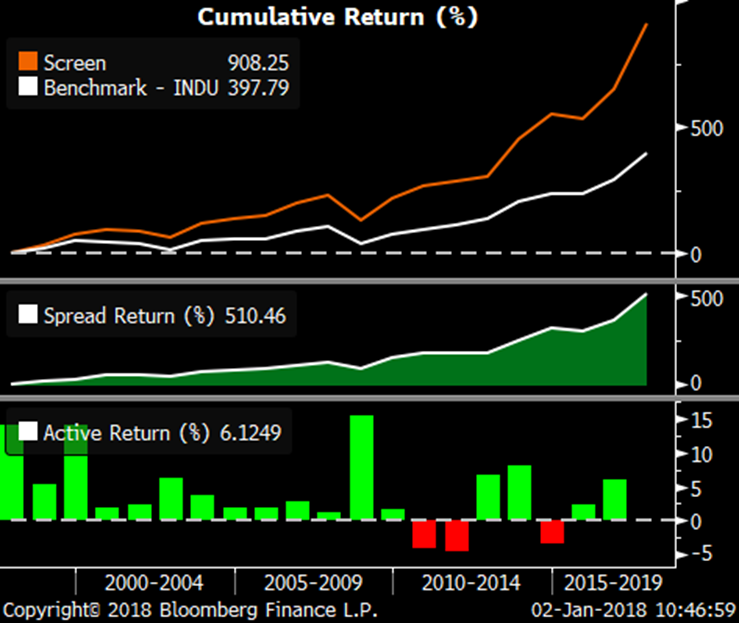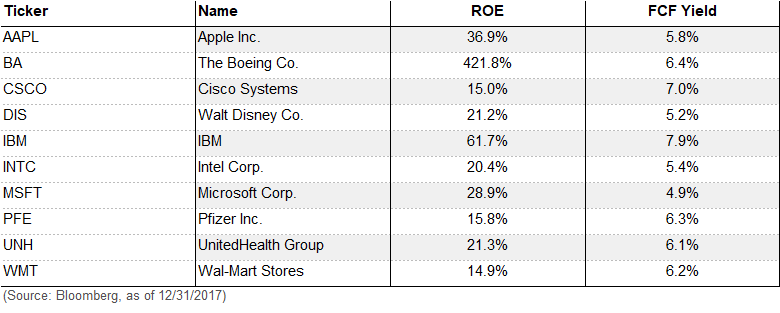A New Strategy For 2018: The Dobermans Of The Dow
Submitted by Silverlight Asset Management, LLC on January 4th, 2018
Karl Friedrich Louis Dobermann was a busy man. In the late 1800’s, he roamed the streets of Germany, collecting both coins and canines, as a tax collector and dog catcher.
Oddly enough, the jobs complemented one another. Tax collecting was a dangerous line of work back then. Collectors were often targeted by thieves and bandits, so Dobermann used stray dogs for protection during his rounds.
One day, he had an idea. What if he could develop a super dog? A special, one of a kind dog to be his loyal companion and protector?
He started a series of breeding experiments. The grand result, unveiled in 1876, became known as the Doberman Pinscher—now considered one of the smartest, most athletic dogs on the planet.
There are no records indicating the precise combination of breeds Dobermann used, although many believe he may have combined a Rottweiler, German Pinscher, and a Black and Tan Manchester Terrier.
***
Left to their own devices, Dobermans assume the alpha role in a household.
In the world of investing, "alpha" is a word used to describe outperformance. A popular screen many investors use to search for outperformance candidates is called, "The Dogs of the Dow."
The strategy is simple: buy the top ten dividend-yielding stocks of the Dow Jones Industrial Average (DJIA) at year-end. Hold for a year, then rinse and repeat.
The strategy has gained notoriety over the years, because it’s easy to follow, and at times has done well.
Yet upon closer inspection, the strategy appears all bark and no bite. Over the last twenty years, from 1998 – 2017, the annual Dogs of the Dow list returned +370%, trailing the Dow’s +397% result over the same period.
One inherent flaw in the screen is its use of dividends alone as a proxy for value. Dividends are fine if a company lacks compelling reinvestment opportunities. But some firms can reinvest at attractive rates of return.
A better proxy for value is the overall free cash flow (FCF) a business generates, i.e. the free cash flow yield. Even still, no single metric fully encompasses the value of a security.
Recall that a Doberman Pincher combines the best elements of several breeds. A better “breed” of stock screen, to borrow a page from Dobermann’s playbook, would seek to engineer a uniquely effective combination of factors.
Free cash flow yield is a value factor that provides a good start. But it only tells us how cheap a security is relative to the current cash being generated.
Another useful factor to consider when evaluating an asset is quality.
“How good” is determined by how much. Specifically, how much cash an asset will generate over its lifetime. Future growth is a crucial consideration in this calculus.
A firm’s sustainable growth rate is the product of two variables: Return on Equity (ROE) and Reinvestment Rate (1 – Dividend Payout Ratio).
It’s obvious that if a company generates high returns on capital and reinvests at high returns, it will do well. But this wouldn’t sell books, so there’s a lot of twaddle and fuzzy concepts that have been introduced that don’t add much.
-Charlie Munger
To keep things simple, let’s concentrate on ROE, and combine that with FCF yield to see if we can invent a superior breed to the traditional Dogs of the Dow.
Here’s how my Dobermans of the Dow screen works.
- Rank Dow components by ROE, and disregard the bottom quartile (i.e. subtract nine names).
- Rank the remaining names by FCF yield, keeping only the top half.
Like the Dogs of the Dow strategy, this exercise gives you about 10 stocks per year. Unlike the Dogs of the Dow strategy, it significantly outperforms.
This sequential screening technique beat the Dow index in 17 of the last 20 years. Meanwhile, its cumulative total return of +908% blew away the benchmark.

There’s a logical basis for why this screen works. Think about when you shop for everyday items. You don’t just buy the cheapest merchandise you can find, do you?
If you’re like most people, you probably also look at the underlying quality of an item. You ask: how good is this compared to alternatives? Then you consider relative price differentials, and determine if it’s a good deal.
The Dogs of the Dow strategy only asks one question: how cheap? And it makes a narrow comparison in delineating that by only considering dividend yields.
The Dobermans of the Dow is a better companion tool for investors, because it’s more dynamic. It starts by sorting Dow constituents by a quality metric (ROE). Then, among those higher quality names, it compares prices in a more universally applicable way (FCF yield).
If this method resonates with you, here’s the 2018 list of Dobermans.

Also published on Forbes.com. Reprinted with permission.
Disclosure: On behalf of clients whose portfolios I supervise, I own positions in AAPL, BA, CSCO, DIS, IBM, PFE, and WMT. I do not have positions in any other stocks mentioned in this article. This material is not intended to be relied upon as a forecast, research or investment advice, and is not a recommendation, offer or solicitation to buy or sell any securities or to adopt any investment strategy. Reliance upon information in this post is at the sole discretion of the reader.
Testimonials Content Block
More Than an Investment Manager—A Trusted Guide to Financial Growth
"I’ve had the great pleasure of having Michael as my investment manager for the past several years. In fact, he is way more than that. He is a trusted guide who coaches his clients to look first at life’s bigger picture and then align their financial decisions to support where they want to go. Michael and his firm take a unique and personal coaching approach that has really resonated for me and helped me to reflect upon my core values and aspirations throughout my investment journey.
Michael’s focus on guiding the "why" behind my financial decisions has been invaluable to me in helping to create a meaningful strategy that has supported both my short-term goals and my long-term dreams. He listens deeply, responds thoughtfully, and engages in a way that has made my investment decisions intentional and personally empowering. With Michael, it’s not just about numbers—it’s about crafting a story of financial growth that has truly supports the life I want to live."
-Karen W.
Beyond financial guidance!
"As a long-term client of Silverlight, I’ve experienced not only market-beating returns but also invaluable coaching and support. Their guidance goes beyond finances—helping me grow, make smarter decisions, and build a life I truly love. Silverlight isn’t just about wealth management; they’re invested in helping me secure my success & future legacy!"
-Chris B.
All You Need Know to Win
“You likely can’t run a four-minute mile but Michael’s new book parses all you need know to win the workaday retirement race. Readable, authoritative, and thorough, you’ll want to spend a lot more than four minutes with it.”
-Ken Fisher
Founder, Executive Chairman and Co-CIO, Fisher Investments
New York Times Bestselling Author and Global Columnist.
Packed with Investment Wisdom
“The sooner you embark on The Four-Minute Retirement Plan, the sooner you’ll start heading in the right direction. This fun, practical, and thoughtful book is packed with investment wisdom; investors of all ages should read it now.”
-Joel Greenblatt
Managing Principal, Gotham Asset Management;
New York Times bestselling author, The Little Book That Beats the Market
Great Full Cycle Investing
“In order to preserve and protect your pile of hard-earned capital, you need to be coached by pros like Michael. He has both the experience and performance in The Game to prove it. This is a great Full Cycle Investing #process book!”
-Keith McCullough
Chief Executive Officer, Hedgeye Risk Management
Author, Diary of a Hedge Fund Manager
Clear Guidance...Essential Reading
“The Four-Minute Retirement Plan masterfully distills the wisdom and experience Michael acquired through years of highly successful wealth management into a concise and actionable plan that can be implemented by everyone. With its clear guidance, hands-on approach, and empowering message, this book is essential reading for anyone who wants to take control of their finances and secure a prosperous future.”
-Vincent Deluard
Director of Global Macro Strategy, StoneX

